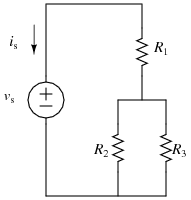Talk:EGR 224/Spring 2010
(Redirected from Talk:EGR 119/Spring 2010)
Jump to navigation
Jump to search
When posting questions, please be sure to use the Q Template so the instructor and TAs will see the question. Note in the examples below the Q Template has been removed to indicate that the question has been answered.
Contents
Questions about particular lectures
Lecture 2 - 1/15
- Here is a sample question - how can you tell what the resistance of a resistor is? DukeEgr93 16:32, 16 January 2010 (EST)
Lecture 3 - 1/22
- I did not do a good job explaining about the signs of current through voltage sources when using equivalent resistances attached to them so I am posting a supplement. If you look at the top figure at right, a valid question might be, "What is the current \(i_s\) as a function of the voltage value \(v_s\) and the resistor values?" The first step in this case might be to determine the equivalent resistance as seen by the voltage source - for this circuit,
\( \begin{align} R_{\mbox{eq}}&=R_1+(R_2\|R_3) \end{align} \) so you can redraw the circuit that way. Then you need to label the current and voltage across the equivalent resistance. You can arbitrarily choose the directionality of one of those variables, and in this case, I chose the voltage since it is in parallel with the voltage source and thus has the same voltage drop across it. I then must draw the current \(i_R\) in the same direction of the voltage drop for the passive sign convention to work. This is in the second image at right.Now that \(v_R\) is known to be \(v_s\) (since they are in parallel), I can use Ohm's Law to find the current through the equivalent resistance:
\( \begin{align} i_R&=\frac{v_R}{R_{\mbox{eq}}}=\frac{v_s}{R_1+(R_2\|R_3)} \end{align} \) What is left is to determine how current \(i_s\) relates to current \(i_R\). That can be done with Kirchhoff's Current Law - perhaps at the top node, where:\( \begin{align} \Sigma i_{\mbox{out}}&=0\\ i_s+i_R&=0\\ i_s&=-i_R=-\frac{v_s}{R_1+(R_2\|R_3)} \end{align} \) or, in terms of equivalent resistance,\( \begin{align} i_s&=-\frac{v_s}{R_{\mbox{eq}}} \end{align} \) where the negative sign is a result of how I chose to label \(i_s\).
Questions about particular homework assignments
Homework 1
- Here is a sample question - how do I get access to any code from class that might be relevant to this or future assignments? DukeEgr93 16:32, 16 January 2010 (EST)
- All codes written in class will go in my ~mrg/EGR119 folder with each day having its own folder. If you use code developed in class. be sure that the comments section at the top of the code indicates that the code is a modified form of my code. Something on the order of:
% [Function or Script Name]
% [Your Name]
% [Date Written]
% Based in part on:
% [Original Function or Script Name]
% [Original author name]
% Accessed on: [Date accessed]
% With my NET ID as a signature, I hereby indicate that I understand and
% have followed the Duke Community Standard in completing this assignment
% Signed: [Your NET ID]
- should work. DukeEgr93 16:32, 16 January 2010 (EST)

